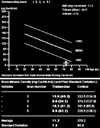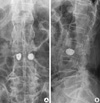Abstract
Ankylosing spondylitis (AS) is an inflammatory disease primarily affecting the spine. Osteoporosis can be a complication of AS and associated with low bone mineral density. As well, spinal fractures in the AS are usually unstable and may cause neurologic deficit at the mainly cervical region with low energy trauma. However, reports of lumbar compression fracture in AS are very rare. Thus, we report a 73-year-old male patient with osteoporotic L3 compression fracture with AS treated with kyphoplasty which has no symptom improvement with conservative treatment. Kyphoplasty is a useful procedure option in the treatment of the lumbar compression fracture in AS.
Ankylosing spondylitis (AS) is characterized by inflammation of the enthuses and paravertebral structures, leading in time to bone formation at those sites.[1] Osteoporosis can be a complication of AS and associated with low bone mineral density (BMD) and the risk of spinal fracture may be 7-fold increase compared with healthy individuals.[2] But, diagnosing spinal osteoporosis can be difficult since pathologic new bone formation interferes with the assessment of the BMD. [3] Spine fracture in AS are unique and have only been described in relatively small case series and delayed diagnosis of fracture in patients with AS often occur due to previous symptom associated with ankylosing spine disorder.[4] Spine fracture that occur in patients with AS are usually unstable three column hyperextension fracture that most commonly affect the cervical region and have a complication such as neurologic deterioration. Thus, the prognosis is worse compared to the general spine trauma population.[5] However, reports of lumbar compression fracture in AS are very rare. Thus, we report a case with osteoporotic lumbar compression fracture with AS treated with kyphoplasty which has no symptom improvement with conservative treatment.
A 73-year-old male patient had lower back and both buttock pain that was occurred after fall from standing position 2 weeks before, the symptoms progressed and became intolerable in spite of analgesia. In the past medical history, no special diseases such as diabetes, hypertension and cerebrovascular diseases were present and he was a non-smoker and a non-drinker. He had 171 cm of height, 70 kg of body weight, 23.9 kg/m2 of body mass index. Laboratory test showed the result of white blood cell (WBC) count of 4,440/mm3, erythrocyte sedimentation rate (ESR) 33 mm/hr, C-reactive protein (CRP) 0.04 mg/dL, uric acid 2.1 mg/dL, RA factor 12.29 U/mL, and HLA-B27 positive. BMD was measured utilizing peripheral-quantitative computed tomography (P-QCT; Somatom sensation 16, Simens, Erlangen, Germany). In result, severe osteoporosis was considered with BMD and T-score of lumbar vertebrae (L1-4) were 11.2 mg/cm3 and -6.17 (Fig. 1). At the time of visiting, simple spine radiography showed syndesmophytes of the spine, suggesting a bamboo spine coexist with ankylosis, but spine fracture was not clearly depicted in lumbar spine (Fig. 2). Three dimensional (3-D) CT and magnetic resonance imaging (MRI) of the lumbar spine reveled ankylosed of ligaments, intervertebral discs, endplate, and of apophyseal structures and 2 column compression fracture on L3 through the vertebral body (Fig. 3).
Kyphoplasty polymethylmetacrylate (PMMA) vertebral augmentation procedure was performed because of progressive vertebral collapsing during the follow-up. Patients were placed in the prone position under bi-plane fluoroscopic guidance and local anesthesia with bilateral transpedicular approach using simultaneous anteroposterior and lateral fluoroscopy. The balloon tamp was situated under collapsed end plate and slowly inflated until it abutted the cortical margins. PMMA was then injected into void of the vertebral body, 3 mL of PMMA was used (Fig. 4). Post-operative thoracolumbosacral orthosis (TLSO) applying, patients encourage to resume all his normal daily activities without any restrictions. The visual analogue scale (VAS) was 10 for the first time. The last VAS was 3 after post-operative 9 months, there were no complication. Last follow-up after post-operative 12 months, the patient is active and satisfied with the treatment including osteoporosis medication. This report was informed to a patient.
In AS spontaneous fusion of the sacroiliac joints and spine occurs due to chronic inflammation leading to initial back pain followed by generalized stiffness of the spine. The disease has a prevalence of 0.1-1.4%: typically affect males and usually becomes apparent between 20 and 30 years of age.[1] Due to multilevel bony union, long lever arms develop in the spinal column on which force can act during trauma.[6] Fractures in the AS tend to be unstable (3-column injury), because ossified ligaments and surrounding tissue also fracture and have an increased fracture risk even after minor trauma and was localized in the cervical spine.[5] Mac Millan et al.[7] stated that traumatic fractures in patients with a partially fused spine tend to occur adjacent to the fused segments, rather than through the fused region itself. Liu et al.[8] reported the fracture line in the patient of AS may be through the vertebral body, but more often through the disc space. The unstable nature of even harmless-appearing injuries dictates that most fractures require long-segment posterior fixation, along with posterior decompression if deemed necessary. Delayed diagnosis occurred in 19% of AS-related spine fracture and often result in neurologic compromise, and then additional imaging techniques such as bone scintigraphy, CT and MRI are than necessary for adequate diagnosis and this delay can contribute to a worse outcome.[4] In this case, spine fracture that occur in the lumbar spine, in the fused region, in the anterior and middle column (2-column injury through the vertebral body) with intact posterior column and treated only with kyphoplasty not fixation operation.
Osteoporosis and spinal fractures are now well recognized features in patients with AS. Bone is a target in many inflammatory rheumatic diseases, including AS. Inflammation leads to a wide range of changes in bone, and especially bone remodeling.[9] In AS bone loss has been documented, but measuring bone density in the spine is hampered by pathologic new bone formation in syndesmophytes and periosteal bone formation. The new bone formation causes an overestimation of the total BMD and values can be normal or high, even when osteoporosis is present. Osteoporosis was often undiagnosed and untreated, particularly in male patient with AS. Older age and long disease duration, impaired back mobility, syndesmophyte formation and elevated inflammatory parameters, indicated increased risk of osteoporosis.[3,10] Furthermore, the ankylosed spine is prone to fracture after minor trauma due to these changes in its biomechanical properties, and the risk of spinal compression fracture.[10] In this case, severe osteoporosis was considered with trabecular and cortical BMD were 279.2 mg/cm3 and 11.2 mg/cm3 of lumbar vertebrae (L1-4).
We experienced a rare case of 2-column compression fracture lumbar spine, with treated kyphoplasty in relation severe osteoporosis. When the back pain exacerbated suddenly in the old aged patients of AS, should be consider of fractures and diagnosed with CT or MRI. Kyphoplasty is a useful procedure option in the treatment of the lumbar compression fracture in AS.
Figures and Tables
Fig. 1
Bone mineral density of the lumbar spine by peripheral-quantitative computed tomography (P-QCT).

Fig. 2
Preoperative simple anteroposterior (A) and lateral (B) L-spine radiography show syndesmophytes of the spine, but spine fracture was not clearly depicted in lumbar spine.

Fig. 3
Coronal image (A) and saggital image (B) of lumbar spine 3-dimensional computed tomography scan and T1-weighted saggital image (C) of lumbosacral magnetic resonance imaging shows ankylosed of ligaments, intervertebral discs, endplate, and of apophyseal structures and 2 column compression fracture on L3 through the vertebral body (arrow).

References
2. Calin A, Fries JF. Striking prevalence of ankylosing spondylitis in "healthy" w27 positive males and females. N Engl J Med. 1975. 293:835–839.

3. Klingberg E, Lorentzon M, Mellström D, et al. Osteoporosis in ankylosing spondylitis - prevalence, risk factors and methods of assessment. Arthritis Res Ther. 2012. 14:R108.

4. Caron T, Bransford R, Nguyen Q, et al. Spine fractures in patients with ankylosing spinal disorders. Spine (Phila Pa 1976). 2010. 35:E458–E464.

5. Westerveld LA, Verlaan JJ, Oner FC. Spinal fractures in patients with ankylosing spinal disorders: a systematic review of the literature on treatment, neurological status and complications. Eur Spine J. 2009. 18:145–156.

6. Einsiedel T, Schmelz A, Arand M, et al. Injuries of the cervical spine in patients with ankylosing spondylitis: experience at two trauma centers. J Neurosurg Spine. 2006. 5:33–45.

7. Mac Millan M, Stauffer ES. Traumatic instability in the previously fused cervical spine. J Spinal Disord. 1991. 4:449–454.

8. Liu X, Bai RX, Li DD, et al. Analysis of the thoracolumbar fracture with ankylosing spondylitis. Zhongguo Gu Shang. 2009. 22:488–490.




 PDF
PDF ePub
ePub Citation
Citation Print
Print



 XML Download
XML Download